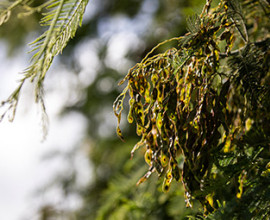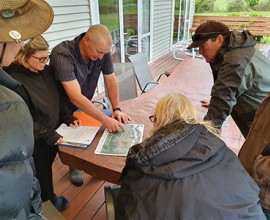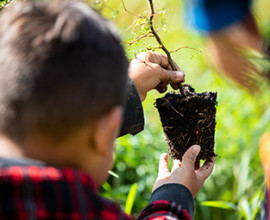Kaikōura Water Zone Committee progress report
Each of Waitaha/Canterbury’s water zone committees has an action plan which outlines how they will work with the community to deliver their aspirations for freshwater as outlined in the Canterbury Water Management Strategy (CWMS). Committees report annually to let the CWMS partners and community know how things are tracking.
2022/23 Progress report
From the chair: Community involvement key to kaitiakitanga
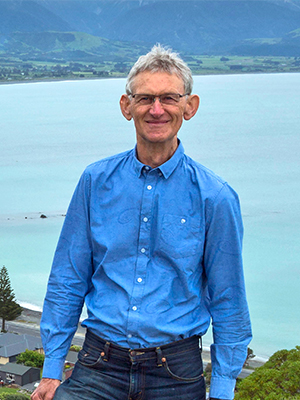
Ted Howard, Kaikōura Water Zone Committee Chair.
From 1 June 2014 to the end of May 2015 we had 374mm of rain on the peninsula, last year we had 1297mm, and our long-term average is 664mm. In between drought and dampness, we had an earthquake. We have fuel prices going up, and commodity prices going down. That is a lot of stress for those involved in agriculture.
It is a testament to the human spirit of cooperation and responsibility that we have found a coalition of the willing and prepared to put time and resources into many projects restoring natural water systems. My compliments and gratitude to all who have contributed in any way to the many projects on the flats, up Inland Road, and throughout our zone.
As I write this, satellite global ocean surface temperatures are higher than ever recorded for this time of year, by a greater margin than has ever been recorded. A hotter ocean means more water evaporating, which means more clouds and more energy into storm systems, so bigger and more frequent storms, but not necessarily on us this year.
As our understanding of complex systems grows, it is clear that cooperation and responsibility are fundamental to the emergence and survival of complexity. I thank all who are cooperating responsibly and encourage everyone else to think seriously about it.
Ted Howard.
Key achievements for 2022/23
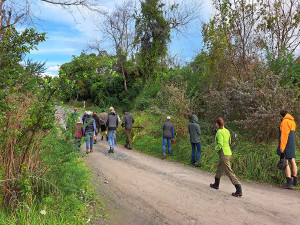
Workshop attendees at the Weedy Workshop, held 30 May 2023. It brought together a great mix of local landowners, interested community members, ECan & local DOC staff.
-
Complete spend of 22/23 CWMS budget – Hapuku Catchment Collective Initiative year two, wetland and riparian restoration support project, Waiau Toa/Clarence River rafting trapping project.
-
Successful ‘Weedy Workshop’ held at Hapuku, as part of the Hapuku Catchment Collective Initiative
-
Addition of the first Youth Rep to the committee table – July 2023
-
Allocation of funds to two projects within the 23/24 Action Plan Budget – Waiau Toa Hapuā protection and Waikoau/Lyell Creek Beach Clean-up and Seaweek community event 2024.
-
Waiau Toa Community Hui – October 2022. Strengthening and collaboration between rūnanga, agencies, stakeholders, and community. Greater sharing of knowledge and resources to support freshwater and environmental outcomes in the Waiau Toa. Effective and planned communication and engagement between different groups and the community. Greater visibility of roles, projects and successes in the Waiau Toa.
-
Action Plan review – Sept/Oct 2022
Delivering the community's vision for freshwater
The Canterbury Water Management Strategy (CWMS) puts some responsibility for finding solutions for freshwater management in the hands of the community, with support from councils, Ngāi Tahu, and others. The strategy sets out freshwater goals and targets to deliver the community’s vision for freshwater.
Each of the community-led water zone committees work collaboratively to develop freshwater recommendations for councils to help ensure plans give effect to these goals and targets.
Within each target area, there are several specific time-bound targets to be achieved and these are monitored and reported on to ensure progress is being made.
The CWMS targets are: Environmental limits, Ecosystem health and biodiversity, Natural character of braided rivers, Kaitiakitanga, Drinking water, Recreational and amenity opportunities, Water use efficiency, Irrigated land area, Energy security and efficiency and Indicators of regional and national economies.
Local projects helping to deliver on the CWMS targets
Read some of the stories about what is being done in the zone to deliver on the CWMS targets:
Working with key partners
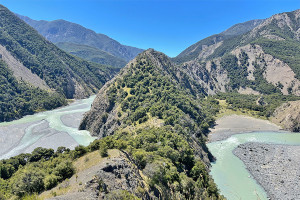
Waiau Toa/Clarence River is culturally significant to locals
The Waiau Toa/Clarence River is of huge significance for its biodiversity, its geomorphology, extensive recreational opportunities, and its whakapapa status to Ngāti Kurī. Since 2014, the committee, landowners, Environment Canterbury, Department of Conservation, Toitū Te Whenua Land Information NZ, and the community have collaborated to address the ongoing weed and predator issues in the catchment.
The Waiau Toa is an enduring priority for the zone committee and much work has been carried out to identify opportunities to support the ongoing mahi in the catchment including actions focused on closer collaboration and helping tell the story of the Waiau Toa and the importance of looking after the awa to community and recreational users. The committee looks forward to further collaboration with the Waiau Toa community and stakeholders to protect and enhance the awa. Clean water, healthy life!
This work helps meet these CWMS targets: Ecosystem health and biodiversity, Natural character of braided rivers, Kaitiakitanga and Recreational and amenity opportunities
Action Plan budget projects
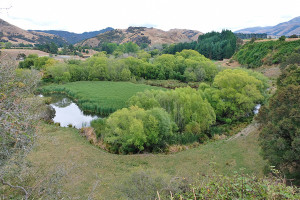
Greenburn wetland - one of the wetland projects in the Kaikōura catchment
The Committee has supported existing Environment Canterbury-managed wetland and riparian restoration projects to help maintain native plantings and control brush weeds. These projects are on private land with landowners making their own contributions to the projects. These projects were previously funded by Environment Canterbury's Zone Delivery team (with one exception) however, Zone Delivery was unable to financially support the projects in this financial year. Our Action Plan funding allowed the completion of these projects which can be handed over to the relevant parties for future and ongoing maintenance.
Greenburn wetland
- The Zone Committee recommended Action Plan funding for this project.
- The project saw over 2 hectares of wetland being protected and restored to increase biodiversity and improve water quality and has involved fencing off areas of wetlands and streams with generous buffers, willow removal, weed control, planting, and predator control.
- The site has seen phenomenal growth but requires another round of maintenance.
- A direct seeding and non-direct seeding regeneration trial is taking place on-site.
- A multitude of landowner contributions were made including trap checking and erecting fence lines.
Find out more about the Greenburn wetland.
Montegues Stream, wetlands, and Warrens Creek
- Environment Canterbury staff have been working with landowners to protect, enhance, and invest in freshwater quality on farms while allowing business continuity.
- The Kaikōura Plains Recovery Project focused on fencing and planting an overland flow path area to increase filtration of runoff in order to improve freshwater quality and habitat of the Lyell Creek catchment. It also enhances visual amenity and provides habitat for wetland species. It was then supported further through increased fencing setback and planting.
- There was some planting loss, however, the remaining plants are knee-high and will increase the chances of success for any new plants. The aim is to do less and do it better with concentrated planting 1m apart in nodes.
- Landowner contributions include planting trees, putting on guards, and taking care of some of the infill planting.
Find out more about the Montegues wetland.
Nagari Wetland
- Nagari Wetland is one of the most significantly restored wetlands in the Canterbury region covering around 7 hectares of land in two areas along Warrens Creek.
- The wetland was closed off ten years ago in order to restore it to pre-settlement conditions and provide habitat for pūkeko.
- Willow control works have been completed along with kahikatea planting.
- Proposing one more round of plant maintenance to improve the success of plantings.
- Landowner contributions include planting and putting on guards.
Find out more about the Nagari wetland.
Rockwood
- In good condition with several plants.
- One more round of maintenance, then to be handed over to the farmer for ongoing maintenance – including brush weed control.
This work helps meet these CWMS targets: Ecosystem health and biodiversity and Kaitiakitanga
Ground work in the zone
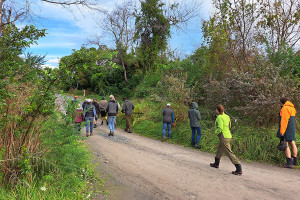
Locals and landowners come together to learn about weed management
The Hāpuku Catchment Collective initiative takes an integrated approach to addressing issues and enhancing freshwater through an offer to people living in the community catchment of Hāpuku South.
The project will enable collaborative and coordinated community actions which support the CWMS and environmental outcomes and will be managed by Environment Canterbury's Zone Delivery team with the support of the CWMS facilitation team.
Year three builds on previous mahi undertaken in years one and two and sees the community catchment area expanded by broadening community engagement. Funds will go towards incentivising work as per years one and two, including site visits with landowners who have shown interest; follow-up weed control work on the year one and two properties; additional community engagement (weedy workshop) to bring people in the catchment together, encourage a catchment group to be formed, and provide education on weed management.
This work helps meet these CWMS targets: Ecosystem health and biodiversity and Kaitiakitanga
Future challenges and opportunities – 2023/24
There are two massive challenges that are related and growing more urgent by the day: climate change and the impact of increasing fuel costs.
The world’s oceans are warming at an alarming rate, and that will lead to bigger storms more often. It isn’t theoretical any longer, now it is a measurable fact. Big storms mean a greater likelihood of crop failure, floods, and fires. Change is needed, quickly.
We have to stop using fossil fuels, but without fundamental economic reform internationally, that is impossible. In the existing system, as fuel costs go up, everything gets more expensive. That means less money available to do the things that don’t generate money.
Those making big money from fossil fuels use every tool available to keep on doing so.
The good news is that there is serious discussion happening about the need for systemic change, and if it happens, the future can be better than most imagine possible.
It is not all doom and gloom, and it is now beyond any shadow of reasonable doubt that business as usual is not a survivable path.
Some of the needed change is above our pay grade, and we can each be responsible, to the best of our limited and fallible abilities.
Previous progress reports
2021 progress report
2020 progress report
2020 Progress Report

Ted Howard, Kaikōura Water Zone Committee Chair.
From the chair: Kaitiakitanga heart of environment awareness
Our committee is made up of a group of people who are passionate about water and the many levels of life it sustains. Our members have lots of different backgrounds, experiences, and expertise to draw from.
This year, Covid-19 Level 4 restrictions presented some challenges that meant we quickly became familiar with online meetings – something that helped us stay connected, even if it was through a screen.
We were pleased to be able to recommend several biodiversity projects for Immediate Steps funding, which shows how dedicated our landowners are to enhancing and protecting the local environment.
More generally, over the past five years as Chair, it has been great to see many environmental projects delivered and so many people engaged.
Challenges have arisen over the years, most memorably the damage caused by the earthquakes, but this just highlights the complexities of nature.
These complex natural systems are constantly changing and working with them requires a willingness to constantly observe and adapt.
This is the heart of environmental awareness and responsibility; it is part of kaitiakitanga/guardianship of our natural world.
It is inspiring to see so many people who care about our beautiful taiao and are willing to take action to protect it for future generations.
We hope to be able to continue supporting these actions and initiatives – it is a journey, always, and we look forward to the next year of this journey with you.
Committees key achievements 2020
- The Waiau Toa/Clarence Weed Control Project received a $250,000 funding boost from Land Information New Zealand (LINZ). The project initially received IMS funding to protect indigenous biodiversity through ongoing weed and pest control in the catchment.
- North Canterbury Transport Infrastructure Recovery (NCTIR) kept the committee up-to-date on their environmental and ecological work to mitigate impacts on local flora and fauna during earthquake recovery programme. The transport corridor is a committee priority.
- Mill Road wetland, Greenburn wetland, Kōmanawa o te Waikōau and Poipoi Kotare Stream were all recommended for IMS funding. These projects contribute to increased biodiversity values and water quality across the district.
- Committee member Tony Blunt was one of the key speakers at Kaikōura’s first regenerative farming event.
Delivering the community's vision for freshwater
The Canterbury Water Management Strategy (CWMS) puts finding solutions for freshwater management in the hands of the community, with support from councils, Ngāi Tahu, and others. The strategy sets out freshwater goals and targets to deliver the community’s vision for freshwater.
Each of the community-led water zone committees work collaboratively to develop freshwater recommendations to ensure council plans give effect to these goals and targets.
Within each target area, there are several specific time-bound targets to be achieved and these are monitored and reported on to ensure progress is being made.
The CWMS targets are:
The CWMS targets are: Environmental limits, Ecosystem health and biodiversity, Natural character of braided rivers, Kaitiakitanga, Drinking water, Recreational and amenity opportunities, Water use efficiency, Irrigated land area, Energy security and efficiency and Indicators of regional and national economies.
Local projects helping to deliver on the CWMS targets
Read some of the stories about what is being done in the zone to achieve deliver on the CWMS targets.
The transport corridor remains one of the zone committee’s top priorities in the Kaikōura Zone Implementation Plan (ZIP).
The committee was thrilled to have been kept up to date by North Canterbury Transport Infrastructure Recovery alliance (NCTIR) as work progressed.
NCTIR has undertaken works on nearly every bridge and culvert crossing along the coast, with careful planning to reduce the effects on native fish.
More than 5,500 fish have been salvaged during stream works and NCTIR has reinstated fish passages in places where infrastructure had eroded and blocked off fish access to upper waterways.
All fish caught during NCTIR’s work has been reported to the New Zealand freshwater fish database, providing information to a national ‘big-picture’ for fish species – something the committee is pleased that anyone, anywhere can access.
This work helps meet these CWMS targets: Ecosystem health and biodiversity, Kaitiakitanga, Indicators of regional and national economies
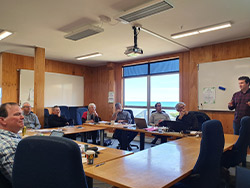
NCTIR’s Project Ecologist Gareth Taylor presents to the KWZC on work to mitigate impacts on local flora and fauna.
Water Zone Committee member Tony Blunt was one of the key speakers at Kaikōura’s first regenerative farming event, which drew interest from farmers, vintners, and industry professionals across the South Island.
The event was hosted by local regenerative farming awareness platform Agregenz and sponsored by the North Canterbury Rural Support Trust and the Organic Dairy and Pastoral Group. Kaikōura Plains Recovery Project also supported the event.
Tony was pleased that new and innovative ideas are weaving their way into farming practice, helping to improve on-farm land and water management, a priority outcome for the committee.
With regenerative farming a bit of a hot topic at the moment, Tony hoped that the event provided everyone with context and experience to help them understand what regenerative farming is all about.
This work helps meet these CWMS targets: Environmental limits, Ecosystem health and biodiversity, Kaitiakitanga, Drinking water, Water use efficiency, and Indicators of regional and national economies
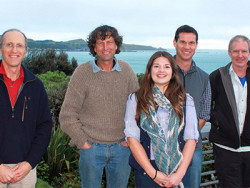
John King, Tony Blunt, Sky Horton (event organiser), Hamish Bielski and James Costello.
Mt Fyffe Farm wetland was mapped earlier in 2020, with important plant species found such as harakeke, purei (sedges), and swamp astelia, which is uncommon on New Zealand's East Coast.
With the protection of biodiversity and improvement of streams and wetlands as priority outcomes in the Kaikōura Zone Implementation Plan (ZIP) (PDF file, 4.71MB), the committee recommended this project for up to $18,000 of IMS funding.
Around 1.9 hectares of wetland will be fenced and protected on the sheep and beef farm, with additional planting and seeding, and weed and predator control.
The protection of the mānuka-dominant wetland is a step towards fulfilling obligations to protect endemic biodiversity and local identity, as the unique environment shapes the community.
The zone committee unanimously supported the project and believes that it helps meet targets for biodiversity and habitat creation, as set out in the Canterbury Water Management Strategy (CWMS).
This work helps meet these CWMS targets: Environmental limits, Ecosystem health and biodiversity and Kaitiakitanga

Our ecologist Helen Greenep at Mt Fyffe Farm wetland.
2019 progress report
2018 progress report
Download the 2018 progress report (PDF File, 5.88MB)

